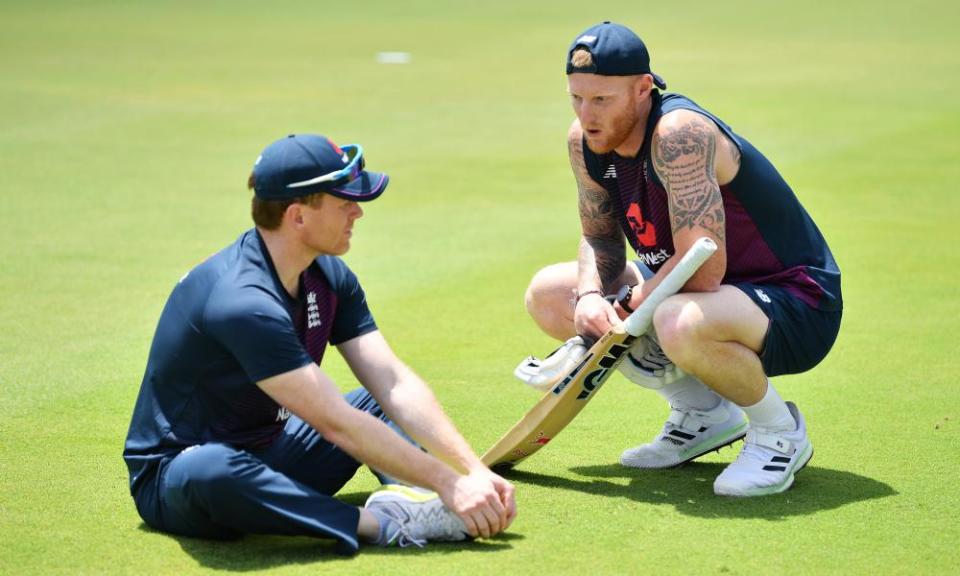Morgan’s greatest legacy may be how Stokes is reshaping Test team in his image

There is one aspect of the Test captaincy Ben Stokes hasn’t warmed to in these past few weeks, and that is answering everybody else’s questions about how he does it. “Have you been wondering what all the fuss is about captaincy in Test cricket?” Stokes was asked on Tuesday. “I mean it’s quite annoying having to do this when I’d rather be in the dressing room celebrating with the other lads,” Stokes laughed, only half-joking. Clarity. Positivity. Simplicity. There’s only so many ways he can explain it before you start to think that, as Louis Armstrong said, if you’ve got to ask then you’re never going to know.
There was one question he welcomed, though. And it was his next one, from an Indian journalist who wanted to know if Stokes thought the way England were playing might change how other teams do too. “I’ve been waiting for that for five weeks,” he said. “That’s what we want to do, we want to create a legacy in Test cricket, we’ve done it in white-ball cricket and we’ve seen other teams follow in our footsteps.” He went on to explain how much he had “loved” the century Rishabh Pant scored in the first innings. “The more we see players like that succeed, the more the negativity around that type of play will die out.”
Related: Brendon McCullum plans golf and adventure holiday for England players
Stokes has never once mentioned what he learned from playing under Alastair Cook and Joe Root, men who you might find pictured in the MCC manual about English Test captaincy. Instead he talks about modelling himself on the former white-ball captain Eoin Morgan. He did it again on Tuesday: “I’ve taken a lot of his messaging and how he wanted the team in one-day cricket to go forward and I’ve brought that mentality and ethos into this Test environment.”
Try to pick the most important performance in the last decade of English Test cricket. Maybe it is Stokes’s own innings at Headingley in 2019, or Kevin Pietersen’s hundred against South Africa at that same ground seven years earlier, one of Alastair Cook’s three back-to-back centuries in India later that winter, or Stuart Broad’s eight for 15 against Australia at Trent Bridge in 2015. It might even be one of the four run chases they have completed in the past five weeks. One place you probably wouldn’t go to is Chester-le-Street in the summer of 2015, and Morgan’s golden duck in the deciding game of a five-match one-day international series against New Zealand.
The story of that series is pretty well-known. It was England’s first since they were knocked out in the pool stages of the 2015 World Cup. Morgan, who had taken over as captain two months before the tournament started, got to pick his own team, playing in the way he wanted, and they had peeled off scores of 408, 365, 302 and 350 in back-to-back matches. Morgan’s dismissal in that fifth match has been mentioned plenty of times, too. Paul Farbrace, the assistant coach, brought it up on the radio just this week. England were 20 for two, chasing 192 from 26 overs, the series was on the line, and Morgan slog-swept his very first ball straight to deep midwicket.
Related: Stokes wants England to be rock stars, says Root as India are left all shook up
It was the moment Morgan’s team really began to understand how committed he was to this new, aggressive style of play, and how much he wanted them to do things the same way. Stokes was next man in, and made 17 off 13. The influence of that innings on England’s run to the 2019 World Cup has been spoken about. What no one saw coming, though, was that it would end up having such a roundabout influence on the way the Test team are playing now. Because if you want to understand why Stokes has spent the last five weeks batting like a man trying to bail water out of a sinking rowboat in the middle of the Atlantic Ocean, there’s your answer.
He is trying to teach his team the same lessons Morgan did his – that it is OK to fail this way, that if you can’t win he would rather you died trying. If you want to know why England are persisting with Zak Crawley even though he is averaging 17 this summer, think about how Morgan stuck with Jason Roy in that series, when he averaged 19 in five innings, and how reassuring that was for the other players in the squad to know Roy wasn’t going to be dropped because he kept getting caught.
Jos Buttler starts his new job as Morgan’s full-time replacement when England play India in the first T20 on Thursday, but it is becoming increasingly clear that he is not the only English captain who is following in his footsteps. While Root was in charge, England tried to marry up their red and white-ball teams by bringing players such as Buttler and Roy across from one to the other. Stokes is doing it by replicating the environment Morgan created that enabled them to play that way. Which makes sense for a generation of players raised on T20 cricket. If your resources don’t suit the way Test cricket is usually played, then stop trying to play it that way.
All of which leaves Morgan looking like an even more influential than he already was. He only played 16 Tests, the last of them over a decade ago, and spent the last few years of his career actively avoiding red-ball cricket, and yet he has somehow ended up with a legacy in Test cricket. It may be his most impressive trick yet.

 Yahoo Sport
Yahoo Sport 





































